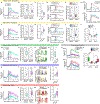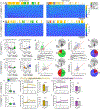Distinct hypothalamic control of same- and opposite-sex mounting behaviour in mice
- PMID: 33268894
- PMCID: PMC7899581
- DOI: 10.1038/s41586-020-2995-0
Distinct hypothalamic control of same- and opposite-sex mounting behaviour in mice
Erratum in
-
Publisher Correction: Distinct hypothalamic control of same- and opposite-sex mounting behaviour in mice.Nature. 2021 Jan;589(7842):E9. doi: 10.1038/s41586-020-03143-1. Nature. 2021. PMID: 33408419 No abstract available.
Abstract
Animal behaviours that are superficially similar can express different intents in different contexts, but how this flexibility is achieved at the level of neural circuits is not understood. For example, males of many species can exhibit mounting behaviour towards same- or opposite-sex conspecifics1, but it is unclear whether the intent and neural encoding of these behaviours are similar or different. Here we show that female- and male-directed mounting in male laboratory mice are distinguishable by the presence or absence of ultrasonic vocalizations (USVs)2-4, respectively. These and additional behavioural data suggest that most male-directed mounting is aggressive, although in rare cases it can be sexual. We investigated whether USV+ and USV- mounting use the same or distinct hypothalamic neural substrates. Micro-endoscopic imaging of neurons positive for oestrogen receptor 1 (ESR1) in either the medial preoptic area (MPOA) or the ventromedial hypothalamus, ventrolateral subdivision (VMHvl) revealed distinct patterns of neuronal activity during USV+ and USV- mounting, and the type of mounting could be decoded from population activity in either region. Intersectional optogenetic stimulation of MPOA neurons that express ESR1 and vesicular GABA transporter (VGAT) (MPOAESR1∩VGAT neurons) robustly promoted USV+ mounting, and converted male-directed attack to mounting with USVs. By contrast, stimulation of VMHvl neurons that express ESR1 (VMHvlESR1 neurons) promoted USV- mounting, and inhibited the USVs evoked by female urine. Terminal stimulation experiments suggest that these complementary inhibitory effects are mediated by reciprocal projections between the MPOA and VMHvl. Together, these data identify a hypothalamic subpopulation that is genetically enriched for neurons that causally induce a male reproductive behavioural state, and indicate that reproductive and aggressive states are represented by distinct population codes distributed between MPOAESR1 and VMHvlESR1 neurons, respectively. Thus, similar behaviours that express different internal states are encoded by distinct hypothalamic neuronal populations.
Figures














Similar articles
-
Transformations of neural representations in a social behaviour network.Nature. 2022 Aug;608(7924):741-749. doi: 10.1038/s41586-022-05057-6. Epub 2022 Aug 3. Nature. 2022. PMID: 35922505 Free PMC article.
-
Scalable control of mounting and attack by Esr1+ neurons in the ventromedial hypothalamus.Nature. 2014 May 29;509(7502):627-32. doi: 10.1038/nature13169. Epub 2014 Apr 16. Nature. 2014. PMID: 24739975 Free PMC article.
-
Estrogen Receptor Alpha-Expressing Neurons in Bed Nucleus of the Stria Terminalis and Hypothalamus Encoding Aggression and Mating.eNeuro. 2024 Nov 26;11(11):ENEURO.0218-24.2024. doi: 10.1523/ENEURO.0218-24.2024. Print 2024 Nov. eNeuro. 2024. PMID: 39592221 Free PMC article. Review.
-
Medial Preoptic Area Modulates Courtship Ultrasonic Vocalization in Adult Male Mice.Neurosci Bull. 2019 Aug;35(4):697-708. doi: 10.1007/s12264-019-00365-w. Epub 2019 Mar 21. Neurosci Bull. 2019. PMID: 30900143 Free PMC article.
-
Neural circuit mechanisms that govern inter-male attack in mice.Cell Mol Life Sci. 2021 Dec;78(23):7289-7307. doi: 10.1007/s00018-021-03956-x. Epub 2021 Oct 23. Cell Mol Life Sci. 2021. PMID: 34687319 Free PMC article. Review.
Cited by
-
HI-FISH: WHOLE BRAIN IN SITU MAPPING OF NEURONAL ACTIVATION IN DROSOPHILA DURING SOCIAL BEHAVIORS AND OPTOGENETIC STIMULATION.bioRxiv [Preprint]. 2024 Aug 13:2023.09.28.560045. doi: 10.1101/2023.09.28.560045. bioRxiv. 2024. Update in: Elife. 2024 Nov 28;12:RP92380. doi: 10.7554/eLife.92380. PMID: 37808781 Free PMC article. Updated. Preprint.
-
Distinct oxytocin signaling pathways synergistically mediate rescue-like behavior in mice.Proc Natl Acad Sci U S A. 2025 Apr 29;122(17):e2423374122. doi: 10.1073/pnas.2423374122. Epub 2025 Apr 23. Proc Natl Acad Sci U S A. 2025. PMID: 40267134
-
Estrous Cycle-Dependent Modulation of Sexual Receptivity in Female Mice by Estrogen Receptor Beta-Expressing Cells in the Dorsal Raphe Nucleus.J Neurosci. 2024 Nov 27;44(48):e1137242024. doi: 10.1523/JNEUROSCI.1137-24.2024. J Neurosci. 2024. PMID: 39299803 Free PMC article.
-
Complementary lateral hypothalamic populations resist hunger pressure to balance nutritional and social needs.Cell Metab. 2023 Mar 7;35(3):456-471.e6. doi: 10.1016/j.cmet.2023.02.008. Epub 2023 Feb 23. Cell Metab. 2023. PMID: 36827985 Free PMC article.
-
The emergence and influence of internal states.Neuron. 2022 Aug 17;110(16):2545-2570. doi: 10.1016/j.neuron.2022.04.030. Epub 2022 May 27. Neuron. 2022. PMID: 35643077 Free PMC article. Review.
References
-
- Bailey NW & Zuk M Same-sex sexual behavior and evolution. Trends Ecol. Evol 24, 439–446 (2009). - PubMed
-
- Nyby J Ultrasonic vocalizations during sex behavior of male house mice (Mus musculus): a description. Behav. Neural Biol 39, 128–134 (1983). - PubMed
-
- White NR, Prasad M, Barfield RJ & Nyby JG 40- and 70-kHz vocalizations of mice (Mus musculus) during copulation. Physiol. Behav 63, 467–473 (1998). - PubMed
Publication types
MeSH terms
Substances
Grants and funding
LinkOut - more resources
Full Text Sources
Molecular Biology Databases
Research Materials
Miscellaneous

